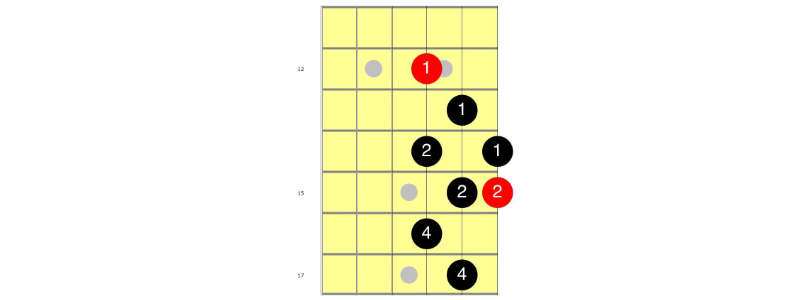November 26, 2020 by Klaus Crow

Good day everyone, today I’ve put together all the lessons from the “One-Octave Major Scale Guitar Series” into one complete lesson. It doesn’t matter if you start from scratch or if you’ve already gone through all the lessons from the last couple of weeks, now is your chance to pick up your guitar, take this valuable guitar lesson of the one-octave major scale patterns and work on it every day. It will definitely make you a better guitar player.
Guitar students usually first learn two-octave scales, but one-octave scales are the building bricks of those two-octave scales and have their own effective purpose that will serve your playing in many ways.
Why You Want to Learn One Octave Scales
One of the reasons you want to learn one-octave scales is because of their simplicity. By using only one octave it’s easier to see the shape and structure of the scale, the notes within the scale, and the intervals. The scale is more user-friendly, easier to play, memorize and apply around the fretboard.
There’s another great benefit to learning one-octave scales. Once you got them under your fingers it’s only a matter of connecting the dots to lay out two octave and three-octave scales, since they are made up of one-octave scales.
Note: In this lesson you will learn one-octave major scale shapes across the entire guitar neck that will help you understand and own the entire major scale landscape.
Starting from the Root Note
We’re learning the three major scale shape/patterns with the first (root) note starting on the Low E-string (6th string), A-string (5th string), D-string (4th string) and the G-string (3rd string). For each string starting point we have three different patterns, which are all one and the same scale with the same notes, all starting from the same root note.
Tip: Learn and memorize the notes for each string so you know the notes and recognize the key of the scale when you move the scale up or down the fretboard. This will benefit your playing tremendeously now and in the long run.
Major Scale Fingering
For the major scale shapes / patterns in the tablature below I’ve notated the left hand fingering (for right handed players). The numbers next to the notes on the note staff right above the tablature indicate the left hand fingers:
1 = index
2 = middle finger
3 = ring finger
4 = pinky
The numbers in the yellow neck diagrams also indicate the fingers. The neck diagrams also clearly show what the shape or pattern looks like. Learn to visualize and memorize the shape of each pattern, so you learn to think in shapes rather than fret numbers.
Alternative Picking Technique
Make sure you play the scale shapes using alternative picking. Hold the pick between your thumb and index finger with the pointed end facing toward the strings. Strictly use alternating down and up strokes. The first note you play is a downstroke, the second an upstroke, the third one a downstroke, the fourth one an upstroke and so on.
Key of the Scale
In the examples below we play the G major scale, but it’s the goal to learn these scale shapes/patterns in every key, so you become an accomplished guitar player.
Once you got the scale under your fingers learn the pattern in different keys. Just move the entire scale up or down the fret to change keys. If you need some extra explanation on how to move a pattern up or down the fretboard you can find some examples for each pattern in Part I
Now let’s practice. Take it one scale at a time. Be patient, focused and practice on a regular basis.
Go get ‘m!
MAJOR SCALE – ROOT NOTE ON 6TH STRING
G MAJOR SCALE SHAPE / PATTERN #1


G MAJOR SCALE SHAPE / PATTERN #2


G MAJOR SCALE SHAPE / PATTERN #3


MAJOR SCALE – ROOT NOTE ON 5TH STRING
G MAJOR SCALE SHAPE / PATTERN #4


G MAJOR SCALE SHAPE / PATTERN #5


G MAJOR SCALE SHAPE / PATTERN #6


MAJOR SCALE – ROOT NOTE ON 4TH STRING
G MAJOR SCALE SHAPE / PATTERN #7


G MAJOR SCALE SHAPE / PATTERN #8


G MAJOR SCALE SHAPE / PATTERN #9


MAJOR SCALE – ROOT NOTE ON 3RD STRING
G MAJOR SCALE SHAPE / PATTERN #10


G MAJOR SCALE SHAPE / PATTERN #11


G MAJOR SCALE SHAPE / PATTERN #12


Assignments:
- Practice each scale pattern thoroughly. One at a time.
- Vividly memorize the shape and the fingering of each scale pattern.
- Learn and memorize all the notes on the fretboard so you know the notes and the key of the scale.
- Memorize where the root notes are located.
- Learn and practice the one-octave major scale shapes in different keys.
- Play the scales along with a metronome gradually increasing the bpm.
- Try to create some melody and learn to solo with the scale patterns over a major scale chord progression. Experiment with playing notes from the scale in a different order, using rhythm and different note lengths, and pauses. Try to come up with your own melody or play an existing melody you already know. Play around with the notes. It’s such a valuable lesson. Dare to experiment!
- Bonus Intermediate/Advanced Assignment: Call out the note names while you’re playing the notes of the scale. G major scale: G – A – B – C – D – E – F# – G | C major scale = C – D – E – F – G – A – B – C | F major scale = F – G – A – Bb – C – D – E – F | Do this exercise in all 12 keys.
P.S.
Share your comments below. I really appreciate it and I’ll reply.
BLACKFRIDAY OFFER 50COOLBLUESLICKS COURSE
DISCOUNT CODE: BFGH50CBL
Get out of a rut with Klaus Crow from Guitarhabits!
Master The Art of Blues and Rock Soloing and
Improvisation around The Entire Fretboard. Check out:

hey Klaus
I appreciate you putting all these lessons together. I will be coming back to this post again and again.
Cheers! Adam
Hi Adam,
It’s a great lesson to come back to everyday.
Keep up the practice and don’t forget the assignments at the end of the post.
Best,
Klaus Crow
I like this approach. I don’t always practice all these scale patterns; I normally only practice on strings 6 & 5.
That said, two suggestions:
1) Since I know you are using Neck Diagrams, the option for showing the Fret number would be helpful, and
2) Since we are learning a Scale, why not write the scale notation with the correct sharps and flats rather than the accidentals?
Hi Mark,
(1) If you look closely you can see the fret numbers right next to the scale diagrams. I admit they are a bit small, but the neck diagrams are actually there to show you the shape and the fingering of each scale pattern rather than the frets.
(2) You mean to notate the sharp or flats at the beginning of the measure. That’s a good idea to recognize the key signature. I’ll take that into account for the next post.
Thanks for your comment. Love it!
Best,
Klaus Crow
Hey Klaus,
Looks great. Once you can find the root notes relatively easily, I teach a lesson called the ‘Magic Box’ based on your shapes 3, 6, 9, and 12 above, because of its basic uniformity of shape across the strings (with the B sting moving things around :( ). Plus, the positions of the notes allows the easiest jump into visualizing 4 widely used Modal patterns with really easy moves in the base shape (Ionian, Mixolydian (flat7), Dorian (flat7&3), and Aeolian (flat7&3&6)). Anyway, wanted to say “good on ya” for the content and the site. Carry on.
Hi Norman,
I see what you mean. That’s a great way to explain and visualize the modes compared to the major scale.
Thanks for reaching out. I appreciate it.
Best,
Klaus Crow
Good Morning Klaus
Just wanted to thank you for all the work you have done putting this together.
6 years ago, I bought myself an acoustic for my 55 birthday. I told myself I was going to learn how to play.
Now here I am, 6 years later, with a repertoire of about 40 songs that I can play pretty much from memory.
Along my adventure (sometimes I call it a torture trip) in learning the guitar, I came to the understanding that in order to really know the guitar, I must learn music theory.
That is where you have helped me excel. After learning my scales, I hit a road block that was hard to get over. Your simple explanations of how to use the scales in a improv setting has taken me to a new level.
While I have zero interest in play in a band, my ability to sit around with a few guys in a pickers circle has made me not regret my decision to learn how to play.
Its been a long hard road that demands time and patience but it was worth every minute
Thanks again
Michael
Hi Michael,
Wow, It’s really great to hear you’ve leveled up your skills and been persistent in your pursuit of learning the guitar, despite the moments of torture ;)
I’ve been there, and still am now and then. Those challenging moments come and go along with moments of euphoria.
I can’t deny that it flatters me to hear Guitarhabits as been a help in your journey of improving your guitar playing.
This is what keeps me motivated to create new lessons and write new material again and again.
Thank you so much.
Keep picking, memorizing and improving!
Best,
Klaus Crow
Really great post. In my experience, limiting “what I am looking” by using smaller chunks, like one octave scales, is really helpful when improvising. It makes it easy to shift modes, and actually makes it easier to string together march larger lines.
Which would be my suggestion as a follow up :)
How to rotate through modalities based on the one octave major scales to be more dynamic on the fly.
Good stuff – Thank you for sharing it!